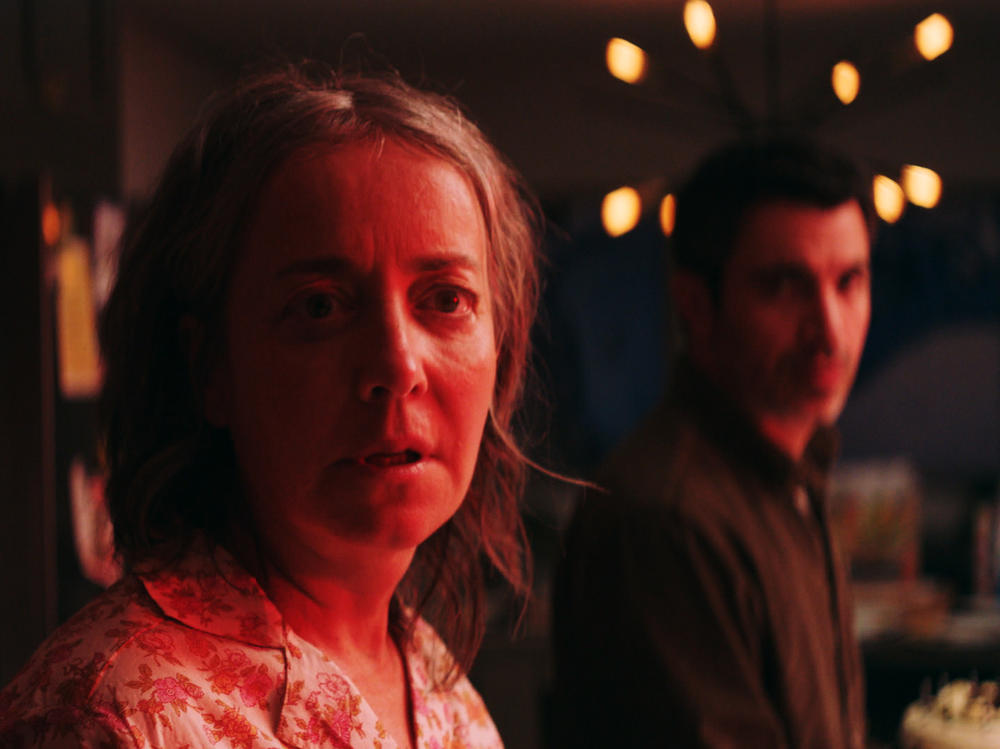Section Branding
Header Content
'She Dies Tomorrow' Is A Mood
Primary Content
"Go for a walk," urges Jane (Jane Adams), whose friend Amy (Kate Lyn Sheil) has just called her sounding distressed, "or maybe watch a movie."
Amy sighs despondently. "A movie's an hour and a half," she says.
Been there, Amy. Am there, more often than it's comfortable to acknowledge. The events of 2020 have sent us all spiraling, albeit along different pathways, but one widely expressed common element is how difficult it's proving to muster the amount of sustained concentration required to sit through a film at home.
And make no mistake — She Dies Tomorrow, by writer/director Amy Seimetz, is the kind of movie that demands the full and continuous attention of its audience, daring them to reach for their phones while its characters spend long moments staring out windows or up at the ceiling, as they sprawl across the floor in fits of abject despair.
That the film is a moody wallow in the contagious nature of anxiety, paranoia and fatalistic dread makes it, as you might imagine, the Most 2020 Movie of 2020. As we watch Amy's unshakable conviction that she will die the next day spread through the rest of the cast like a kind of emo zombie plague, She Dies Tomorrow seems destined to join Easy Rider, Wall Street and Hell or High Water among the pantheon of Films Emblematic Of Their Eras. (We can consider the past six months of a global pandemic its own era, right? Feels like it.)
Despite how redolent the film is of our current cultural/psychological/political moment, the fact that it is only being released to drive-ins this weekend, and on VOD next weekend, means that the year 2020 is doing Seimetz's movie no favors. She Dies Tomorrow would hugely benefit from being seen in a theater, and not only because doing so would obviate the many distractions associated with home viewing — phones, roommates, family, pets, anxiety over the state of the world gnawing through one's stomach lining, etc.
But also: It's funny.
Bleakly funny, to be clear. Darkly funny. No-Light-Can-Escape Funny. Not-For-Everyone Funny.
Consider: To establish that Amy is ... going through something, Seimetz doesn't merely have her moon about her tasteful, newly purchased L.A. home while sighing.
I mean ... she does do that, yeah, but Seimetz — and Sheil — don't stop there, because they need to underscore that Amy is in a real bad way. So Amy doesn't merely sigh, she launches into crying jags. She trance-dances in her living room ... to Mozart's Requiem in D.
Twice.
She leans against her blank living room wall, striking poses of Munchian despair. She sprawls on her couch, reaching down to fondle the grain of her hardwood floors. She drinks, and shops online for funereal urns, and wonders if she could have her skin turned into a smart leather jacket, so that she might be "useful in death."
Watching these scenes alone at home, they risk coming off effortful, po-faced, gravid with strained portentousness. In a theater, however, they'd more easily come off as clearly intended — they'd be a hoot.
Jane Adams, as Amy's friend Jane, is perfectly cast as someone whom Amy looks to for steadfast support, but who's seen by her family (brother Chris Messina and sister-in-law Katie Aselton) as a fraying, needy kook. Adams has often played the supportive best friend, the glossed-over romantic interest, and its great to see her getting to use her full range of seriocomic chops here. Jane's desperation ratchets up gradually, then frantically, with Adams fully in control of its shadings.
Sheil is denied any such clear, calibrated arc for much of the film — Amy's pretty much zoned out from the jump — but a few nicely placed flashbacks provide some key insights into how she arrived at where we meet her at the start of the movie.
They're emotional insights, not expository ones. She Dies Tomorrow provides no answers, and can barely be bothered with questions, and that ambiguity is the point. It's possible to intellectually appreciate that Seimetz is content to toy with conventions of the horror genre even as she withholds any of its satisfying, pulpy delights. What we get instead is more pleasing aesthetically than viscerally — rainbow-hued lighting to denote the presence of the supernatural (or entirely natural, if that's your take), vivid images of blood-microscopy to imply that the ideological disease has a biological basis. It's intentional, that holding back — but it means that the film's ending leaves you not so much in suspense, but suspended in air.
In another era, you'd stream out of the theater and huddle in the lobby in tight little clots of your fellow humans, furiously theorizing.
Today, however, you're more likely to turn to the dog sleeping at your feet, or the houseplant in the corner. Both will prove less-than-insightful, vis-a-vis the movie's themes, though the houseplant will probably bring up the menstrual imagery Seimetz suddenly introduces in its closing moments, at which point you will realize you should really go for a walk.
Copyright 2020 NPR. To see more, visit https://www.npr.org.
Bottom Content




